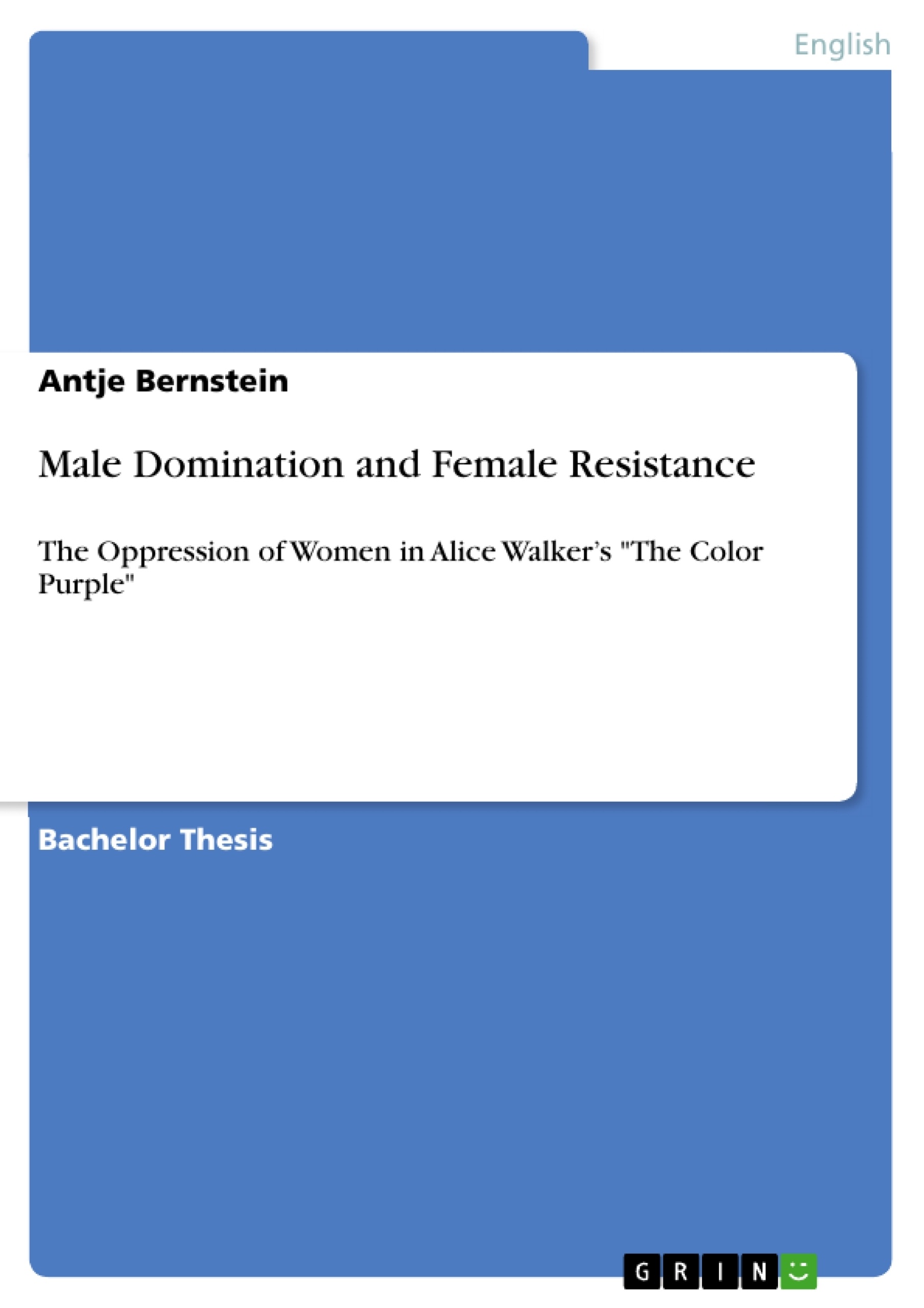Of course, the [whites] oppress us, they oppress the world. Who’s got his big white foot on the whole world? The white man, the rich white man. But we also oppress each other and we oppress ourselves. I think that one of the traditions we have in Black Women’s literature is a tradition of trying to fight all the oppression. (Walker, Sojourner 14)
(Christophe, p. 102)
The question of domination and resistance has been one of the major problems in interpersonal relationships ever since. Whereas there are diverse forms of domination and oppression, the issue of females being dominated by men is one of the most crucial to Alice Walker. Consequently she focuses on black-on-black violence between the characters in her novel The Color Purple. Often criticized for not dealing with the problem of racism and discrimination of African American by their white fellow-citizens in the first place but concentrating on the disproportion between the sexes, Alice Walker aims at the creation of equality between men and women due to the fact that it is important to her to strive for a solution of the problems she experiences in her immediate environment, namely black communities, first: “I mean to deal with the guy who beat you up in your house and then see who’s beating you up on the street. (Sojourner 14)” (Christophe, p. 102). Only by solving the problems that exist between African Americans a strong community that can overcome greater issues as discrimination by whites can come into being.
To create awareness of the fact that the discrimination most African Americans suffer from also exists within their own community, Walker deals with the oppression of women in black communities rather than with racism. Nevertheless there are significant similarities between racism and the treatment of women to be found in her novel. The fact that a group of human beings is considered to be less valuable and thus can be dominated by a supposedly superior group is the same in racism and slavery as in the oppression of women. The concept of a relationship between a person who dominates and a person who obeys underlies the relationship between master and slave and some of the relationships between the male and female characters in the novel alike. These parallels will be dealt with as well as with the way the female characters try to resist.[...]
Inhaltsverzeichnis (Table of Contents)
- Introduction
- Male Domination: The Oppression of Women and their Response
- Celie and Alphonso
- Celie and Albert
- Sofia and Harpo
- Mary Agnes and Harpo
- Conclusion
- Making a Quilt - Creating a Network: Female Resistance
- Celie and Shug
- Celie and Sofia
- Sofia and Mary Agnes
- Conclusion
- The Cycle of violence: Origins of Male Aggression
- Albert and his father
- Albert and Harpo
- Conclusion
- Conclusion
Zielsetzung und Themenschwerpunkte (Objectives and Key Themes)
This academic paper analyzes the themes of male domination and female resistance in Alice Walker's novel The Color Purple. The paper explores the various forms of oppression faced by women within the context of African American communities and examines the ways in which women challenge and overcome these oppressive structures. Key themes explored include:- The impact of male dominance on women's lives
- The importance of female solidarity and support networks
- The cyclical nature of violence and its roots
- The role of personal agency and self-discovery in overcoming oppression
Zusammenfassung der Kapitel (Chapter Summaries)
The paper begins with an introduction that establishes the context for understanding male domination and female resistance in the novel. It highlights the importance of addressing oppression within African American communities and the significance of Alice Walker's focus on the relationship between black men and women.
The first section explores the various forms of male domination experienced by the female characters. It examines the relationships between Celie and Alphonso, Celie and Albert, Sofia and Harpo, and Mary Agnes and Harpo, highlighting the patterns of abuse, control, and manipulation that are pervasive in the novel.
The second section shifts focus to the ways in which women resist and create networks of support. It analyzes the relationships between Celie and Shug, Celie and Sofia, and Sofia and Mary Agnes, demonstrating how women empower each other through shared experiences, mentorship, and acts of defiance.
The third section delves into the origins of male aggression, examining the cyclical nature of violence and its impact on the characters. This section focuses on the relationship between Albert and his father and Albert and Harpo, exploring how past experiences of abuse shape the characters' present actions and attitudes.
Schlüsselwörter (Keywords)
This paper primarily focuses on the themes of male dominance, female resistance, oppression, solidarity, violence, and self-discovery within the context of Alice Walker's The Color Purple. It also explores the dynamics of African American communities, the role of personal agency, and the impact of past trauma on present behavior.- Citation du texte
- Antje Bernstein (Auteur), 2007, Male Domination and Female Resistance, Munich, GRIN Verlag, https://www.grin.com/document/182494



